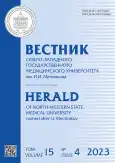Retroperitoneal synovial sarcoma
- Authors: Lisitsyn A.A.1, Zemlyanoy V.P.1, Kotkas I.Е.1, Bekhtereva I.A.1
-
Affiliations:
- North-Western State Medical University named after I.I. Mechnikov
- Issue: Vol 15, No 4 (2023)
- Pages: 81-88
- Section: Case report
- URL: https://journals.rcsi.science/vszgmu/article/view/257468
- DOI: https://doi.org/10.17816/mechnikov624440
- ID: 257468
Cite item
Abstract
Synovial sarcoma of the retroperitoneum is a rare and aggressive tumor. In some cases, differential diagnosis between retroperitoneal sarcoma and adrenocortical cancer is difficult due to the similar clinical and intrascopic manifestations of these neoplasms. The final diagnosis is established based on the results of histological, immunohistochemical and genetic studies. The most important step in the treatment of synovial sarcoma is complete removal of the tumor. However, despite the radical nature of the intervention, the incidence of local relapse and metastasis remains high.
AIM: to conduct a retrospective analysis of the parameters of operated patients with synovial sarcoma of the retroperitoneum.
This study is aimed at studying the results of examination and surgical treatment of patients with synovial sarcoma of the retroperitoneal space who were hospitalized in the E.E. Eichwald Clinic surgical department of the North-Western State Medical University named after. I.I. Mechnikov.
The patients were assessed for hormonal status using an immunoassay to determine the levels of adrenocorticotropic hormone, cortisol, aldosterone, renin, normetanephrine and metanephrine in the blood, and a dexamethasone suppression test has been performed at a dose of 1 mg. High-performance liquid chromatography has determined 6 glucocorticoids in the blood serum: cortisol, cortisone, corticosterone, 11-deoxycorticosterone, 11-dehydrocorticosterone, 11-deoxycortisol. The urine steroid profile was studied in all the patients using gas chromatography-mass spectrometry. All the patients underwent computed tomography of the abdominal organs and retroperitoneal space with contrast, morphological and immunohistochemical examination of the removed material. The material was fixed in 10% neutral buffered formalin. The pieces were then subjected to standard wiring followed by embedding in paraffin. Sections 2–3 microns thick were prepared from the resulting blocks and stained with hematoxylin and eosin. Immunohistochemical studies were performed on paraffin sections. A panel of monoclonal antibodies was used: protein S-100 (poly), pancytokeratin (AE1/AE3), EMA, cytokeratin-8, -18, chromogranin A, synaptophysin, α-inhibin, SOX-10, CD99, TLE-1, bcl- 2, GATA-3. Postoperative outcomes and follow-up were assessed according to the information in the medical records and data obtained from a telephone conversation with each patient. Statistical processing of the results has not been out due to rare cases of the disease.
Full Text
##article.viewOnOriginalSite##About the authors
Aleksandr A. Lisitsyn
North-Western State Medical University named after I.I. Mechnikov
Email: aleksandr.lisitsyn@szgmu.ru
ORCID iD: 0000-0003-2045-0044
SPIN-code: 3237-4309
MD, Cand. Sci. (Med.), Assistant Professor
Russian Federation, 41 Kirochnaya St., Saint Petersburg, 191015Vyacheslav P. Zemlyanoy
North-Western State Medical University named after I.I. Mechnikov
Email: zeml.spb@mail.ru
ORCID iD: 0000-0003-2329-0023
MD, Dr. Sci. (Med.), Professor, Honored Doctor of the Russian Federation
Russian Federation, 41 Kirochnaya St., Saint Petersburg, 191015Inna Е. Kotkas
North-Western State Medical University named after I.I. Mechnikov
Author for correspondence.
Email: inna.kotkas@yandex.ru
ORCID iD: 0000-0003-4605-9887
SPIN-code: 1853-8825
MD, Dr. Sci. (Med.), Professor
Russian Federation, 41 Kirochnaya St., Saint Petersburg, 191015Irina A. Bekhtereva
North-Western State Medical University named after I.I. Mechnikov
Email: Irina.Bekhtereva@szgmu.ru
ORCID iD: 0000-0002-5206-3367
SPIN-code: 3954-2873
MD, Dr. Sci. (Med.), Assistant Professor
Russian Federation, 41 Kirochnaya St., Saint Petersburg, 191015References
- Blay JY, von Mehren M, Jones RL, et al. Synovial sarcoma: characteristics, challenges, and evolving therapeutic strategies. ESMO Open. 2023;8(5):101618. doi: 10.1016/j.esmoop.2023.101618
- Mastoraki A, Schizas D, Papanikolaou IS, et al. Management of primary retroperitoneal synovial sarcoma: A case report and review of literature. World J Gastrointest Surg. 2019;11(1):27–33. doi: 10.4240/wjgs.v11.i1.27
- Ansari Djafari A, Razzaghi M, Rakhshan A, et al. A large primary retroperitoneal synovial sarcoma: a case report of a huge malignant tumor. Iran J Med Sci. 2022;47(3):280–284. doi: 10.30476/IJMS.2021.90470.2141
- Huned D, Kam JH, Lee LS, Tiwari RV. Primary renal synovial sarcoma presenting with a retroperitoneal bleed. BMJ Case Rep. 2021;14(3):e237099. doi: 10.1136/bcr-2020-237099
- Sultan I, Rodriguez-Galindo C, Saab R, et al. Comparing children and adults with synovial sarcoma in the surveillance, epidemiology, and end results program, 1983 to 2005: An analysis of 1268 patients. Cancer. 2009;115:3537–3547. doi: 10.1002/cncr.24424
- Casali PG, Abecassis N, Bauer S, et al. Soft tissue and visceral sarcomas: ESMO–EURACAN Clinical Practice Guidelines for diagnosis, treatment and follow-up. Ann Oncol. 2018;29(Suppl 4):iv51–iv67. doi: 10.1093/annonc/mdy096
- Swallow CJ, Strauss DC, Bonvalot S, et al. Management of Primary Retroperitoneal Sarcoma (RPS) in the adult: An updated consensus approach from the Transatlantic Australasian RPS working group. Ann Surg Oncol. 2021;14:7873–7888. doi: 10.1245/s10434-021-09654-z
- von Mehren M, Kane JM, Bui MM, et al. NCCN Guidelines Insights: Soft Tissue Sarcoma, Version 1.2021. J Natl Compr Canc Netw. 2020;18(12):1604–1612. doi: 10.6004/jnccn.2020.0058
- Dobrindt EM, Saeger W, Bläker H, et al. The challenge to differentiate between sarcoma or adrenal carcinoma — an observational study. Rare Tumors. 2021;13:20363613211057746. doi: 10.1177/20363613211057746
- Wilkinson MJ, Martin JL, Khan AA, et al. Percutaneous core needle biopsy in retroperitoneal sarcomas does not influence local recurrence or overall survival. Ann Surg Oncol. 2015;22:853–858. doi: 10.1245/s10434-014-4059-x
- Straker RJ, Song Y, Shannon AB. Preoperative biopsy in patients with retroperitoneal sarcoma: Usage and outcomes in a national cohort. Ann Surg Oncol. 2021;289(11):6868–6879. doi: 10.1245/s10434-021-09691-8
- Foo WC, Cruise MW, Wick MR, Hornick JL. Immunohistochemical staining for TLE1 distinguishes synovial sarcoma from histologic mimics. Am J Clin Pathol. 2011;135(6):839–844. doi: 10.1309/AJCP45SSNAOPXYXU
- Schmitz E, Nessim C. Retroperitoneal sarcoma care in 2021. Cancers (Basel). 2022;14(5):1293. doi: 10.3390/cancers14051293
Supplementary files












